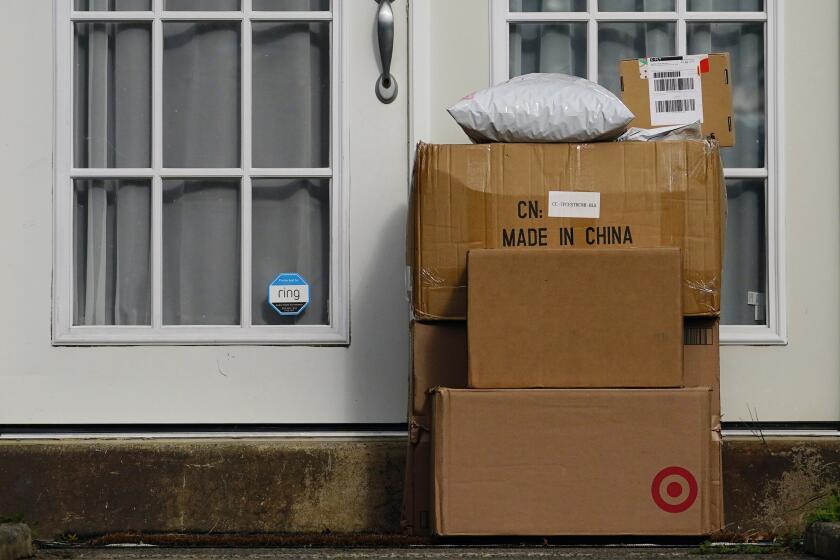Bringing the IRS Into the 21st Century
Computer Sciences Corp. is no stranger to monumental challenges.
When the royal family of Saudi Arabia wanted to set up a computer system for tracking the millions of foreign Muslims who make pilgrimages to mecca every year, it turned to CSC. And when the Federal Aviation Administration needed a new program that would enable air-traffic controllers to guide 60 million planes through U.S. airspace, it too called on the low-profile firm based in El Segundo.
But the information technology company is embarking on the most daunting project in its 40-year history: redressing a long legacy of failure in modernizing the federal tax system by overhauling the technology that enables the Internal Revenue Service to collect $1.7 trillion in taxes.
This is no typical consulting contract--even for one of the top three IT consulting firms in the country. Modernizing the IRS’ 200 computer systems is expected to take between 10 and 15 years at a cost of $5 billion to $7.5 billion. Some analysts predict it could be the largest civilian technology contract ever, although it’s too soon to say how many millions of dollars will flow to CSC.
The IRS contract instantly raises the company’s profile in an industry that is used to working behind the scenes.
Such high stakes don’t come without substantial risk. All previous efforts to bring the IRS out of its technological time warp have failed, despite years of work and billions of dollars. Should CSC and its six partner companies follow suit, their failure would be difficult to hide. It also could reduce earnings for CSC--which made $341 million on revenue of $7.7 billion last year--by 5% to 10%, according to analysts who track the company. Even so, the contract won’t significantly affect CSC’s earnings for a few years.
*
Van Honeycutt, CSC’s president, chairman and chief executive, acknowledges “it would hurt us a lot” if the contract went awry. But he is confident in his company’s ability to succeed.
“People say, ‘My God, how can you expect to manage a big job like the IRS?’ ” Honeycutt said. “We say, ‘That’s all we do.’ ”
But most observers agree that the CSC-led team--known as the Prime Alliance--stands a better chance of success than previous efforts to modernize the agency, which is seen as a critical component of IRS Commissioner Charles Rossotti’s drive to improve customer service and collect more tax. A key reason is that for the first time, the IRS is willing to go to the private sector for help.
Over the last five months, CSC and the companies it leads in the Prime Alliance--Northrop Grumman, IBM, Lucent Technologies, Science Applications International, Unisys and KPMG Peat Marwick--have been developing a plan of attack with the IRS and its advisors, Booz Allen Hamilton and Mitre Corp. The first stages of the implementation are scheduled to begin Oct. 1. At its peak, CSC expects several thousand of its 45,000 employees to be devoted to the project.
When the overhaul is complete, IRS officials say, more taxpayers will be able to file their returns over the phone--and some, perhaps, on the Internet. Refunds will be processed in days instead of weeks, with the money deposited directly into bank accounts. When IRS employees take calls from taxpayers, they will be able to give accurate answers by tapping into databases with up-to-date records. The computer systems will flag potential tax evaders, and the streamlined processes will give tax collectors more time to track down cheaters and make sure they pay.
That vision represents a dramatic change from the hodgepodge of computer systems that store taxpayer records today.
“This is the worst I’ve ever seen,” said Rossotti, who spent 27 years leading a successful technology consulting firm before joining the tax agency in 1997. “It’s like being a bank and not knowing how much money is in your customer’s account. A company couldn’t exist this way and keep its customers happy.”
The need for change is more obvious than the method for implementing it. Rossotti is fond of comparing the challenge to rebuilding New York City--from the skyscrapers to the subway system--while 7.5 million New Yorkers are still living there.
The Computer Sciences team plans to do its work through a series of projects that each will take 18 to 24 months to complete, with two or three going on at any given time. Projects that will do the most to improve customer service--and thereby encourage taxpayer compliance--will be tackled first. These include projects designed to increase electronic-filing capabilities, increase the security of taxpayer more some,,records and expand the use of telephones for customer service and filing of returns, said Don Brown, CSC’s program manager for the IRS contract and vice president of the company’s federal sector in Falls Church, Va.
As the companies decide which problems to fix, they will solicit bids from the private sector. Computer Sciences will then evaluate the bids and make recommendations to the IRS.
The biggest project will be creating modern versions of the so-called master files, the mainframe systems that store and analyze taxpayer records. The 30-year-old master files store 2.5 terabytes of data--the equivalent of 2.5 million books--on computer tapes using technology that predates the databases that are common in corporate America.
IRS employees can’t directly access the master files. Instead, they must work with another database that is perpetually one or two weeks out of date. As a result, IRS customer service representatives often give inaccurate information to callers, and IRS computers sometimes send payment-overdue notices to taxpayers who have already paid their bills.
The new database will solve these and other problems, said Paul Cosgrave, the IRS’ chief information officer. The IRS and CSC are now debating which set of taxpayers to convert to the new system first.
“It could be the wage and income earners, who make up about 90% of filers, in order to move the most people as quickly as possible,” said CSC’s Brown. “It could also be the subset of taxpayers who file EZs and simple 1040s. It might also be medium-sized and large businesses.”
Building the new IRS database won’t be as easy as creating a database from scratch. As filers are moved to the new system, their historical records on the master file must be converted to the new system as well. (CSC and the IRS have not yet decided how much of the data in the master file should be carried over). After all taxpayers are in the new database, the master file will have to be maintained for historical records.
Although the IRS is a unique customer for Computer Sciences, in many ways it functions like any large corporation. For instance, its database may be very similar to one used by a commercial bank, and its call-center operation may resemble that of an insurance company.
So when looking for technology that could be used at the IRS, the bidding companies will examine systems already in place in the business world. The ones that come closest to offering the functionality and features the IRS requires could be adopted and modified for the tax agency.
“We probably won’t find a company with as many customers as the IRS has, but H&R; Block and Intuit both have an engine that can compute your tax to see if it was done right,” Brown said. “Maybe one of their systems can work for the IRS. After all, we only need to compute one account at a time.”
Cosgrave agreed that upgrading the IRS is not “fundamentally different” from upgrading one of CSC’s more typical clients, such as AT&T;, General Motors, DuPont or Pratt & Whitney. Government contracts account for about 25% of the company’s revenue.
But he emphasized that the scope of the project is in a class by itself, with systems involving more than 50 million lines of computer code. If printed onto paper, the code would stack more than three miles high.
“We’re not just tying together a lot of small projects,” Cosgrave said. “The conversion--there’s nothing quite on the same scale.”
*
Size isn’t the only thing that sets the IRS apart from a corporate client. Unlike a corporation, the IRS is not in control of its own fate. Instead, it must enforce a tax code that is created--and frequently changed--by Congress. In fact, Rossotti said, the agency is in the process of making 1,260 changes mandated by Congress.
And because the first part of the year is devoted to collecting taxes, CSC’s window for implementing changes is between July and December.
A more subtle difference is the fact that the IRS can’t pick its customers. Private companies can decide not to serve customers who drain profits, as Fidelity Investments did recently when it cut off standard phone service to about 30,000 mutual fund clients who were calling the company frequently. The Prime Alliance companies lack such options as they look for ways to help the IRS control its costs.
“We can come up with a system that accommodates 80% of the customers, but we still need to meet the needs of the other 20%, no matter how expensive,” said Jim Gander, director of federal imaging and knowledge management for Northrop Grumman’s Logicon unit in Dulles, Va. “It could even be just 1% that’s difficult, but we still have to meet their needs. If this were a company, we could just say we won’t serve them because they’re too expensive.”
Some of the risks involved in a government project are inherently different from those in the private sector. Several members of the Prime Alliance said they fear that Congress will lose interest in the IRS modernization project and cut off funding before the upgrade is complete. CSC executives said their approach--working on only a handful of relatively short-term projects at a time--will minimize their exposure to sudden changes in funding.
*
Another unique risk is that the modernization process could fall victim to politics. Congress might lose the political will to complete the modernization if it results in job cutbacks, said Bill Eldridge, senior project executive for IBM’s federal government services division in Durham, N.C.
Rossotti himself said he fears that members of Congress who don’t understand the complexities of a major technological upgrade could demand that the IRS set aggressive deadlines, then skewer the project if those deadlines are missed.
But there is widespread agreement that the CSC-led team stands a better chance of success than previous efforts to modernize the tax agency.
Unlike past IRS leaders, both Rossotti and Cosgrave have decades of experience deploying information systems in the private sector. Both also understand that the modernization isn’t about buying technology for technology’s sake but is designed to enhance service to taxpayers, said Jerry Agee, vice president of the federal systems unit at TRW, a longtime IRS consultant.
Some congressional critics are heartened to see the IRS seeking help from the private sector rather than trying to do everything by itself. Insistence on keeping the project in-house was a major reason the $3.5-billion modernization effort that lasted from the late 1980s to 1995 ended in failure, said Rep. Rob Portman (R-Ohio), who co-sponsored legislation to reform the IRS.
“The IRS has gotten much more sophisticated and much more willing to reach out,” Portman said. “Charles Rossotti is the first IRS commissioner who truly understands the world of information technology. It’s a new attitude. This is not your father’s Oldsmobile.”
(BEGIN TEXT OF INFOBOX / INFOGRAPHIC)
No Job Too Big?
Computer Sciences Corp.’s massive contract to modernize the computer systems that enable the Internal Revenue Service to collect $1.7 trillion in taxes has thrust the El Segundo-based information technology firm into the spotlight. But CSC chief Van Honeycutt says the company is no stranger to big projects: “That’s all we do.”
More to Read
Inside the business of entertainment
The Wide Shot brings you news, analysis and insights on everything from streaming wars to production — and what it all means for the future.
You may occasionally receive promotional content from the Los Angeles Times.







